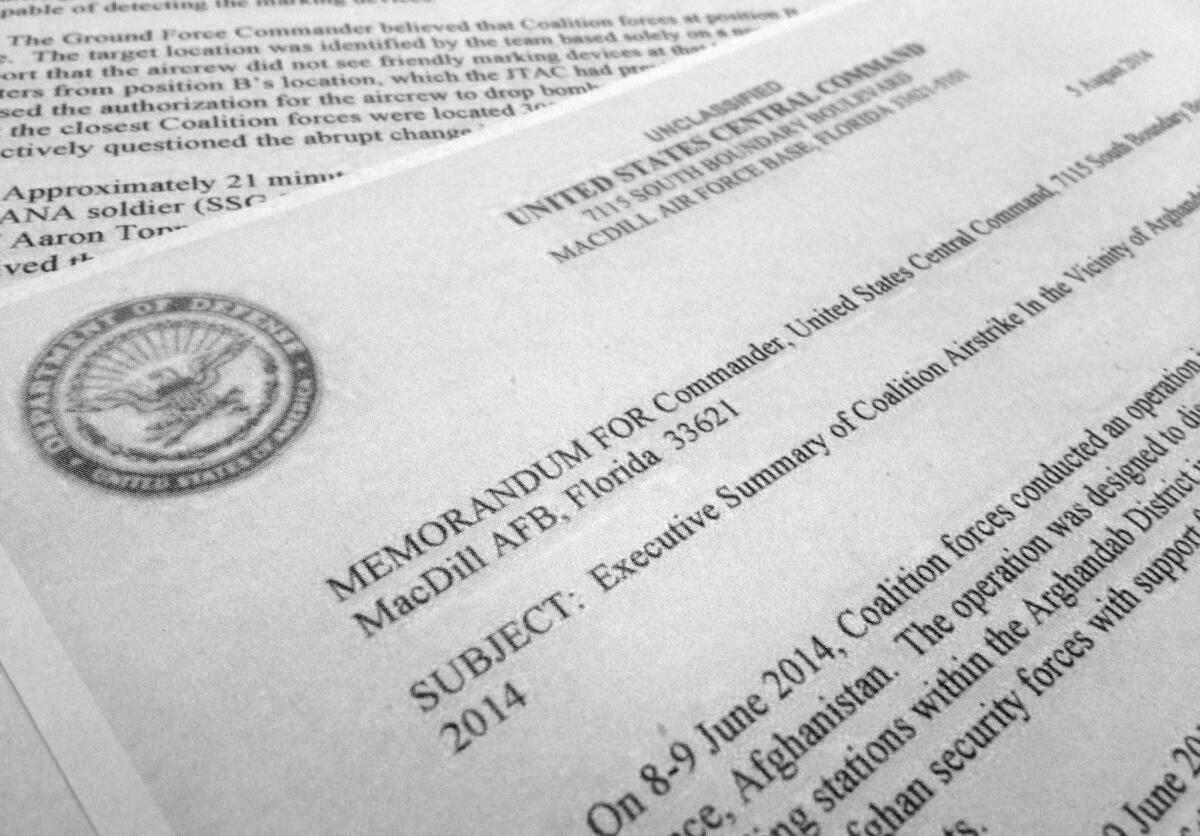Communication errors cited in friendly-fire deaths in Afghanistan

Communication errors by troops on the ground and in the air led to the deaths of five American soldiers and one Afghan during a June battle with insurgents in southern Afghanistan, a Pentagon investigation concluded in a report released Thursday.
In one of the deadliest friendly-fire incidents of the nearly 13-year war, soldiers failed to follow established procedures for relaying their position to an aircraft flying over them, the U.S. Central Command found. Nor did the crew of the Air Force B-1 bomber follow required steps to ensure it knew where ground troops were before releasing a pair of bombs that hit their position.
“Though this was a challenging set of circumstances, had the team executed standard tactics, techniques and procedures and communicated effectively, this tragic incident was avoidable,” Air Force Maj. Gen. Jeffrey Harrigian said in the nearly 300-page report, which was partially redacted before its release under the Freedom of Information Act.
“The key members executing the close air-support mission collectively failed to effectively execute the fundamentals, which resulted in poor situational awareness and improper target identification,” he said.
Few details of the June 9 incident were released at the time, as coalition officials notified soldiers’ families and investigators tried to determine what happened.
The fateful operation, led by Afghans with support from U.S. special forces, was intended to disrupt insurgents and improve security for polling stations before Afghanistan’s presidential runoff election.
The troops came under fire about 7:30 p.m. as they prepared to return to base. They climbed to a ridgeline to gain an advantage against the insurgents who were shooting at them.
But the soldiers did not properly communicate their position to the B-1 bomber crew, which was flying at an altitude of about 12,000 feet providing “close air support,” the report says. Aircrew members mistook muzzle flashes from the U.S. troops on the ridgeline as insurgent fire.
One of the soldiers, Staff Sgt. Scott R. Studenmund, 24, of Pasadena, had an infrared strobe light affixed to the back of his helmet, which was intended to notify friendly forces of their location. The strobe cannot be seen by the naked eye but can be detected by a heat-seeking sensor.
The sensor pods on the B-1 aren’t capable of detecting the infrared strobes, however, and the pilots’ night-vision glasses can detect strobes only at limited ranges, the report says.
The B-1 targeted the ridgeline and dropped two bombs, killing all the soldiers: Studenmund; Staff Sgt. Jason A. McDonald, 28, of Butler, Ga.; Spc. Justin R. Helton, 25, of Beaver, Ohio; Cpl. Justin R. Clouse, 22, of Sprague, Wash.; Pvt. Aaron S. Toppen, 19, of Mokena, Ill.; and Afghan Sgt. Gulbuddin Ghulam Sakhi.
About 30,000 U.S. troops remain in Afghanistan, most of whom are special forces who still conduct regular ground operations in the area of the deadly incident. The Pentagon plans to have just 9,800 troops there by the beginning of 2015.
More to Read
Start your day right
Sign up for Essential California for news, features and recommendations from the L.A. Times and beyond in your inbox six days a week.
You may occasionally receive promotional content from the Los Angeles Times.







